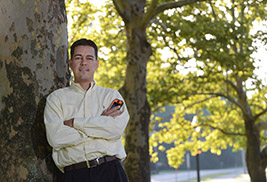Featured Article
Kent State Fashion Grad Wins Supima Design Competition
Kent State Fashion School graduate Anastasia Iafrate was named this year’s winner of the prestigious Supima Design Competition at Mercedes-Benz Fashion Week in New York.
read moreKent State Researchers to Develop Mobile App for Cuyahoga Valley National Park
Posted Sept. 22, 2014 | Cindy WeissVisitors will learn as they go through the park

Richard E. Ferdig, Ph.D., professor in the Research
Center for Education Technology in the College of
Education, Health and Human Services at Kent State, will
lead a team of Kent State researchers to to create a mobile
app to help visitors to Cuyahoga Valley National Park learn
more about the park’s history and ecology. The app also
will feature multiple interactive features, including the ability
to learn more about the history, habitats, geology and scientific
features of the park.
A $952,000 National Science Foundation grant to researchers at Kent State University will result in a mobile device application to help visitors to Cuyahoga Valley National Park learn more about the park’s history and ecology and become “citizen scientists” by sharing their findings with others.
The grant to a team of researchers led by Richard E. Ferdig, Ph.D., professor in the Research Center for Education Technology in the College of Education, Health and Human Services at Kent State, will be used to create a mobile app with multiple interactive features, including the ability to learn more about the history, habitats, geology and scientific features of the park.
Users of the app will be learning science while at the same time helping park rangers and scientists learn about the park’s ecosystem. Park visitors will be able to use the app anonymously and free of charge. They also will be able to log in and save information about their personal park experiences.
The main goals of the project are to explore the feasibility of using GPS-based mobile devices for informal science learning and to understand the impact of such technology.
“We’re really interested in advancing informal science learning in the park while also getting people involved in citizen science – a process where they contribute to our scientific understanding of the environment,” Ferdig says.
Users of the app also may choose to log in and save their findings, creating a record of their discoveries that they can use to plan future visits. The app will work on Apple and Android products, the bulk of the mobile market. Mobile devices will be available for visitors to check out at the park, or visitors can use the app on their own smartphones or devices. The app will not require a wireless connection but will rely on the devices’ built-in GPS.
More than 2.5 million people each year visit Cuyahoga Valley National Park, and visitors make about 110,000 requests of rangers and volunteers for on-the-spot information about its wildlife and resources. As part of the project, funding will be provided to the National Park Service for two seasonal employees to help test and implement the app in Cuyahoga Valley National Park.
“Cuyahoga Valley National Park preserves 33,000 acres of natural open space,” says Jennie Vasarhelyi, chief of interpretation, education and visitor services at Cuyahoga Valley National Park, who will be the lead representative for the park. “It provides an ideal place for learning about science in a fun and appealing setting. We are very pleased that Kent State is leading this project to create new ways for visitors to engage with science while visiting the park.”
The researchers, who include a biologist, a computer scientist and Ferdig, an educational psychologist, will survey users to find out how much they have learned, their attitudes toward personal learning and what interests them. Education traditionally has relied on “teaching as dissemination of content” Ferdig explains, but now people are becoming more involved as creators of their own learning content – the “maker movement.”
While Cuyahoga Valley National Park will be the “lab” for the three-year project, the app could eventually be used in other parks around the world that develop their own databases of content.
Ferdig, principal investigator on the grant, is the Summit Professor of Learning Technologies and Professor of Instructional Technology in the College of Education, Health and Human Services at Kent State. He focuses on innovative learning through technologies and is the founding editor of the International Journal of Gaming and Computer Mediated Simulations.
Other Kent State researchers serving as co-investigators on the grant project are Annette Kratcoski, Ph.D., director of the Research Center for Educational Technology, and Ruoming Jin, Ph.D., associate professor of computer science, from Kent State’s College of Arts and Sciences. Computer Science Professor Cheng-Chang Lu, Ph.D., also will contribute to the project. Biologist Patrick D. Lorch, formerly at Kent State, is now manager of field research for Cleveland Metroparks.
Last year, Kent State signed a five-year agreement with the National Park Service providing for collaborative projects and joint research. To learn more about this, visit www.kent.edu/news/newsdetail.cfm?newsitem=6cf61d78-ad71-6cc2-9f5511ba88320d30.
For more information about research at Kent State, visit www.kent.edu/research.
